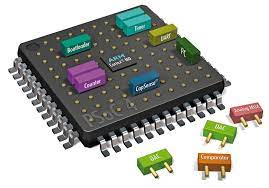A system on a chip, also known as a SoC, is an integrated circuit or an IC that combines a complete electrical or computer system onto a single substrate. It’s a full system on a single chip, as the name says. A central processor unit, input and output ports, internal memory, and analog input and output blocks are just a few of the components that a SoC tries to contain inside itself. Signal processing, wireless communication, artificial intelligence, and other operations can be performed depending on the type of system that has been shrunk to the size of a chip.
What is a System on Chip (SoC)?
The term “system on a chip” refers to a computer that runs on a single chip. This is a chip/integrated circuit that houses numerous computer components on a single substrate, such as silicon, including the CPU (via a microprocessor or microcontroller), memory, input/output (I/O) ports, and secondary storage. SoCs utilize less power and take up less space than their multi-chip equivalents since they have all of these components on one substrate. With the rise of the Internet of Things, as well as edge and mobile computing, SoCs are becoming more prevalent. Consider Intel’s acquisition of SoC firm Silicon Engineering Group in September 2018, as well as previous acquisitions of Altera and others.
Video gaming consoles, such as the Nvidia Tegra X1 in the Nintendo Switch or the AMD Flute and AMD Gonzalo SoCs projected to power the next Xbox and PlayStation, are examples of technology that utilises a SoC. SoCs are also used in Raspberry Pi computers, Arduino boards, and STEM kits. They are frequently used in STEM kits since they are simple to use and hence beneficial in STEM education. SoCs are also used in smartphones and tablets.
3 Different Types of SoCs
Today’s market offers a wide range of System on Chip (SoC) products. We’ve seen different manufacturers take diverse methods to SoC development and marketing since there are no set standards for what qualifies a device as a SoC. Storage, for example, is provided on the SoC in certain circumstances but managed outside the system in others.
In general, SoCs include a microprocessor or a microcontroller, as well as any other peripherals needed to complete the system. We’ll go through some of the more prevalent varieties of SoC in this section. There are three distinct types of SoCs in general.
SoCs that Use Microcontroller
Microcontroller-based system-on-chips (a chip with the CPU, RAM, ROM and potentially other components). Arduino boards, for example, are SoCs that employ a microprocessor (a chip with a CPU only).
The phrases microcontroller and System on a Chip are frequently confused. It’s simple to see why, given that microcontrollers are commonly referred to as single-chip microcomputers. That sounds a lot like the System on a Chip definition.
So, what’s the distinction? A microcontroller’s capabilities are rather limited. In comparison to a complete SoC, the peripherals that may be used with a microcontroller are restricted. A microcontroller, meanwhile, does not often provide the same amount of capability as a System on a Chip. That instance, although a SoC on a smart device may run a whole operating system, microcontrollers typically execute a single program.
Microcontrollers are frequently seen as a component of SoCs. The CC2540 from Texas Instruments, for example, is based on the 8051 microcontroller. With in-system programmable flash, RAM, Bluetooth capabilities, and more, the CC2540 expands the potential of the 8051. Microcontroller-based SoCs such as the CC2540 and others are a key part of what’s driving embedded system growth.
SoCs that use Microprocessor
SoCs for smartphones, such as Qualcomm’s Snapdragon 845 (also used in virtual reality headsets) and Apple’s A12 Bionic SoC, which is included in the iPhone XS, iPhone XS Max, and iPhone XR, are examples. The Raspberry Pi with Intel’s SoC FPGAs.
Qualcomm’s Snapdragon range of devices is one of the most popular SoCs with microprocessors. The Snapdragon 855+ platform, for example, has a Qualcomm Kryo 485 CPU. The Kryo 485 has a GPU (Graphics Processing Unit), WiFi 6 capabilities, an LTE modem, USB-C capability, a camera, and other features.
Snapdragon SoC processors are widely used in smart phones, tablets, and other devices. Engineers wanting to optimize functionality with a small footprint have flocked to them because they provide low power consumption and great computational power.
Applications for ASIC (Application-Specific Integrated Circuit)
SoCs are designed for specialized purposes that may or may not need the usage of a microprocessor or microcontroller. This is referred as as an ASIC (application-specific integrated circuit).
While SoCs are commonly utilized for general-purpose computing in mobile devices, they are also frequently employed for ASIC (Application-Specific Integrated Circuit) applications. In contrast to general-purpose computers, ASICs are built to do a specialized task. In the embedded systems business, these custom applications are fairly frequent.
The ASIC/SoC market is expected to develop at a robust 8.5 percent CAGR (Compound Annual Growth Rate) through 2023, according to Semico’s research. What are the main factors driving the expansion? Artificial Intelligence, IoT, and Industrial IoT (AI). In the coming years, embedded System on Chip SoC technology will transform a variety of sectors.
Fully-programmable SoCs
Most functionality is fixed in programmable SoCs (PSoC), but some functionality is reprogrammable in a manner similar to a field-programmable gate array. If new interfaces are necessary, programmable SoCs allow them to be implemented within the programmable logic.
Components for SOC
An SoC is a chip that has been particularly built to suit the requirements of combining the electrical circuits of several computer components onto a single integrated chip. Rather to assembling several chips and components onto a circuit board, the SoC assembles all essential circuits into a single unit.
Higher development and architectural expenses, more difficult debugging, and poorer IC yields are among the challenges of a SoC. IC is expensive to produce and requires a long time to do so. However, as the technology develops and is implemented, this is likely to change.
Typically, a SoC has the following components:
Utility software for the operating system.
Voltage regulators and power management circuits are two types of voltage regulators.
Oscillators or phase lock loop control systems are examples of timing sources.
A microprocessor, microcontroller, or digital signal processor is a device that processes data.
Real-time clocks, counter timers, and power-on-reset generators are examples of peripherals.
USB, FireWire, Ethernet, universal asynchronous receiver-transmitter, and serial peripheral interface bus are examples of external interfaces.
Digital-to-analog and analog-to-digital converters are examples of analog interfaces.
Memory (RAM and ROM).
Conclusion
In conclusion, a system on a chip (SoC) is a device that incorporates the electrical circuitry of many computer components into a single, integrated chip (IC). A system on a chip (SoC) is an electronic substrate that can include analog, digital, mixed-signal, or radio frequency functionalities. A graphics processing unit (GPU), a multi-core central processor unit (CPU), and system memory are the most common components (RAM).
Therefore, SOCs utilize less power, have higher performance, take up less space, and are more dependable than multi-chip systems since they incorporate both hardware and software. And the majority of today’s system-on-chips are found in mobile devices such as smartphones and tablets.

